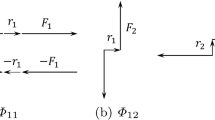Abstract
The mechanical behavior of graded lattice structures whose geometry is created on the basis of the analytical determination of three-dimensional triply periodic minimal surfaces (TPMS) is investigated. Several homogeneous and graded lattice models with different types of representative volume geometry and gradient parameters are considered. The numerical models are validated with data obtained experimentally using the Vic-3D Micro-DIC video system. The results of numerical simulation of the deformation behavior of gradient structures with the Shoen G (gyroid) TPMS geometry under uniaxial compression are presented. The influence of structure parameters and gradient properties on the mechanical behavior is studied.










Similar content being viewed by others
REFERENCES
M. Afshar, A. P. Anaraki, H. Montazerian, and J. Kadkhodapour, “Additive manufacturing and mechanical characterization of graded porosity scaffolds designed based on triply periodic minimal surface architectures,” J. Mech. Behav. Biomed. Mater. 62, 481–494 (2016). https://doi.org/10.1016/j.jmbbm.2016.05.027
L. G. Bracaglia, B. Smith, E. Watson, N. Arumugasaamy, A. G. Mikos, and J. Fisher, “3D printing for the design and fabrication of polymer-based gradient scaffolds,” Acta Biomater. 56, 3–13 (2017). https://doi.org/10.1016/j.actbio.2017.03.030
S. Pagani, E. Liverani, G. Giavaresi, A. De Luca, C. Belvedere, A. Fortunato, A. Leardini, M. Fini, L. Tomesani, and P. Caravaggi, “Mechanical and in vitro biological properties of uniform and graded Cobalt-chrome lattice structures in orthopedic implants,” J. Biomed. Mater. Res., Part B: Appl. Biomater. 109, 2091–2103 (2021). https://doi.org/10.1002/jbm.b.34857
Y. Wang, W. D. Müller, A. Rumjahn, F. Schmidt, and A. D. Schwitalla, “Mechanical properties of fused filament fabricated PEEK for biomedical applications depending on additive manufacturing parameters,” J. Mech. Behav. Biomed. Mater. 115, 104250 (2021). https://doi.org/10.1016/j.jmbbm.2020.104250
X. Li, Y. Z. Xiong, H. Zhang, and R. N. Gao, “Development of functionally graded porous titanium/silk fibroin composite scaffold for bone repair,” Mater. Lett. 282, 128670 (2021). https://doi.org/10.1016/j.matlet.2020.128670
M. Zhao, F. Liu, G. Fu, D. Z. Zhang, T. Zhang, and H. Zhou, “Improved mechanical properties and energy absorption of BCC lattice structures with triply periodic minimal surfaces fabricated by SLM,” Mater. 11, 2411 (2018). https://doi.org/10.3390/ma11122411
F. Liu, Z. Mao, P. Zhang, D. Z. Zhang, J. Jiang, and Z. Ma, “Functionally graded porous scaffolds in multiple patterns: New design method, physical and mechanical properties,” Mater. Des. 160, 849–860 (2018). https://doi.org/10.1016/j.matdes.2018.09.053
X. Shi, W. Liao, T. Liu, C. Zhang, D. Li, W. Jiang, C. Wang, and F. Ren, “Design optimization of multimorphology surface-based lattice structures with density gradients,” Int. J. Adv. Manuf. Technol. 117, 2013–2028 (2021). https://doi.org/10.1007/s00170-021-07175-3
S. Bargmann, B. Klusemann, J. Markmann, J. E. Schnabel, K. Schneider, C. Soyarslan, and J. Wilmers, “Generation of 3D representative volume elements for heterogeneous materials: A review,” Prog. Mater. Sci. 96, 322–384 (2018). https://doi.org/10.1016/j.pmatsci.2018.02.003
C. Han, Y. Li, Q. Wang, S. Wen, Q. Wei, C. Yan, L. Hao, J. Liu, and Y. Shi, “Continuous functionally graded porous titanium scaffolds manufactured by selective laser melting for bone implants,” J. Mech. Behav. Biomed. Mater. 80, 119–127 (2018). https://doi.org/10.1016/j.jmbbm.2018.01.013
J. L. Ng, C. E. Collins, and M. L. Knothe Tate, “Engineering mechanical gradients in next generation biomaterials — Lessons learned from medical textile design,” Acta Biomater. 56, 14–24 (2017). https://doi.org/10.1016/j.actbio.2017.03.004
X. Y. Zhang, G. Fang, S. Leeflang, A. A. Zadpoor, and J. Zhou, “Topological design, permeability and mechanical behavior of additively manufactured functionally graded porous metallic biomaterials,” Acta Biomater. 84, 437–452 (2019). https://doi.org/10.1016/j.actbio.2018.12.013
A. Moetazedian, A. Gleadall, X. Han, and V. V. Silberschmidt, “Effect of environment on mechanical properties of 3D printed polylactide for biomedical applications,” J. Mech. Behav. Biomed. Mater. 102, 103510 (2020). https://doi.org/10.1016/j.jmbbm.2019.103510
L. Ruiz-Cantu, A. Gleadall, C. Faris, J. Segal, K. Shakesheff, and J. Yang, “Multi-material 3D bioprinting of porous constructs for cartilage regeneration,” Mater. Sci. Eng. C, Mater. Bio. Appl. 109, 110578 (2020). https://doi.org/10.1016/j.msec.2019.110578
X. Wang, S. Xu, S. Zhou, W. Xu, M. Leary, P. Choong, M. Qian, M. Brandt, and Y. M. Xie, “Topological design and additive manufacturing of porous metals for bone scaffolds and orthopaedic implants: A review,” Biomaterials 83, 127–141 (2016). https://doi.org/10.1016/j.biomaterials.2016.01.012
Z. Wang, Y. Wang, J. Yan, K. Zhang, F. Lin, L. Xiang, L. Deng, Z. Guan, W. Cui, and H. Zhang, “Pharmaceutical electrospinning and 3D printing scaffold design for bone regeneration,” Adv. Drug Delivery Rev. 174, 504–534 (2021). https://doi.org/10.1016/j.addr.2021.05.007
R. Shah, B. Gashi, S. Hoque, M. Marian, and A. Rosenkranz, “Enhancing mechanical and biomedical properties of protheses — Surface and material design,” Surf. Interf. 27, 101498 (2021). https://doi.org/10.1016/j.surfin.2021.101498
A. Entezari, Z. Zhang, A. Sue, G. Sun, X. Huo, C. C. Chang, S. Zhou, M. V. Swain, and Q. Li, “Nondestructive characterization of bone tissue scaffolds for clinical scenarios,” J. Mech. Behav. Biomed. Mater. 89, 150–161 (2019). https://doi.org/10.1016/j.jmbbm.2018.08.034
H. Razi, S. Checa, K. D. Schaser, and G. N. Duda, “Shaping scaffold structures in rapid manufacturing implants: A modeling approach toward mechano-biologically optimized configurations for large bone defect,” J. Biomed. Mater. Res., Part B 100B, 1736–1745 (2012). https://doi.org/10.1002/jbm.b.32740
L. Zhang, B. Song, L. Yang, and Y. Shi, “Tailored mechanical response and mass transport characteristic of selective laser melted porous metallic biomaterials for bone scaffolds,” Acta Biomater. 112, 298–315 (2020). https://doi.org/10.1016/j.actbio.2020.05.038
M. A. Tashkinov, “Multipoint stochastic approach to localization of microscale elastic behavior of random heterogeneous media,” Comput. Struct. 249, 106474 (2021). https://doi.org/10.1016/j.compstruc.2020.106474
Funding
We gratefully acknowledge financial support from the mega-grant international cooperation program, project no. 075-15-21021-578 of May 31, 2021, hosted by Perm National Research Polytechnic University.
Author information
Authors and Affiliations
Corresponding authors
Additional information
Translated by E. Smirnova
About this article
Cite this article
Elenskaya, N.V., Tashkinov, M.A. & Silberschmidt, V.V. Numerical Modeling of the Deformation Behavior of Polymer Lattice Structures with a Density Gradient Based on Additive Technologies. Vestnik St.Petersb. Univ.Math. 55, 443–452 (2022). https://doi.org/10.1134/S1063454122040045
Received:
Revised:
Accepted:
Published:
Issue Date:
DOI: https://doi.org/10.1134/S1063454122040045




